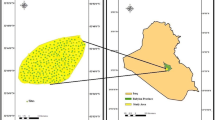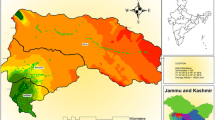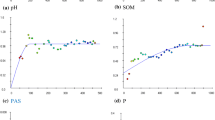Abstract
Knowledge of inherent spatial variability of soil physical and chemical properties is needed for more accurate site-specific management of soil nutrients. In this study we investigated the spatial variability of a wide range of soil physical and chemical properties including soil texture fractions (percentages of sand, silt, and clay denoted as Sand, Silt and Clay, respectively), soil water content (WC), bulk density (BD), gypsum, organic carbon (OC), electrical conductivity (EC), pH, Ca, Mg, Na, exchangeable sodium percentage (ESP), sodium absorption ratio (SAR), available phosphorous (AP), and available potassium (AK) in a saline-alkaline soil catena in Sistan Plain, southeast of Iran. Soil samples were collected from two depths (0–15 and 15–30 cm) on a nearly regular grid at 113 sites over an 85-ha agricultural field. Statistical analysis of soil properties showed that Na, Mg, Ca, WC, EC, ESP, and SAR have a large coefficient of variation (CV) (more than 50%) and BD and pH have a low CV (less than 15%) for both layers. The correlation among soil properties varies for two layers; while Silt, WC, EC, ESP, Na, and gypsum are statistically (p < 0.01 and p < 0.05) correlated with most of physical and chemical properties in topsoil, Sand, EC, and OC are the most dominant properties in subsoil. Geostatistical autocorrelation analysis of soil properties were examined based on the “range of spatial continuity” and “nugget to sill” ratio. Accordingly, AP and subsoil ESP have the lowest spatial correlation while texture fractions are the most auto-correlated variables in space. The spatial structure of soil properties followed either a spherical or an exponential model with a minimum correlation distance of 70 m for AP to almost 800 m for soil fractions. The results indicated that spatial continuity generally increases and decreases with depth for soil physical and chemical properties, respectively. The difference in spatial variability of soil properties could be attributed to internal factors (e.g., the forming processes of soil) as well as external factors (e.g., human activities). The maps of soil physical and quality parameters were generated using either kriging or inverse distance weighting methods depending on cross-validation results. In general, topsoil layer has a greater amount of EC, ESP, SAR, pH, Na, Ca, Mg, and OC than subsoil while Silt, WC, and gypsum were often higher in subsoil. OC maps showed that the whole area is relatively low in organic carbon, mainly due to hot and dry climate and windy conditions in Sistan. The maps of soil nutrients provide useful information for adapting an efficient and precision agricultural production management.




Similar content being viewed by others
References
Abegaz A, Adugna A (2015) Effects of soil depth on the dynamics of selected soil properties among the highlands resources of northeast Wollega, Ethiopia: are these sign of degradation? Solid Earth Discussions 7(3)
Adhikari G, Bhattacharyya KG (2015) Correlation of soil organic carbon and nutrients (NPK) to soil mineralogy, texture, aggregation, and land use pattern. Environ Monit Assess 187:735
Afrasiab P, Delbari M (2013) Assessing the risk of soil vulnerability to wind erosion through conditional simulation of soil water content in Sistan plain, Iran. Environ Earth Sci 70:2895–2905
Amini M, Afyuni M, Khademi H, Abbaspour KC, Schulin R (2005) Mapping risk of cadmium and lead contamination to human health in soils of Central Iran. Sci Total Environ 347:64–77
Ayoubi SH, Mohammad Zamani S, Khormali F (2012) Spatial variability of some soil properties for site specific farming in northern Iran. Intl J Plant Prod 1(2):225–236
Basso B, Ritchie JT (2015) Simulating crop growth and biogeochemical fluxes in response to land management using the SALUS model. In: The ecology of agricultural landscapes: long-term research on the path to sustainability. Oxford University press, New York, NY USA, pp 252–274
Basso B, Bertocco M, Sartori L, Martin EC (2007) Analyzing the effects of climate variability on spatial pattern of yield in a maize-wheat-soybean rotation. Eur J Agron 26:82–91
Bhatti AU, Bakhsh A, Afzal M, Gurmani AH (1999) Spatial variability of soil properties and wheat yields in an irrigated field. Commun Soil Sci Plant Anal 30:1279–1290
Blake GR, Hartge KH (1986) Bulk density. In: Klute, a., Ed., methods of soil analysis, part 1-physical and mineralogical methods, 2nd ed. agronomy monograph 9, am Soc Agron-soil Sci Soc am, Madison
Blumfield TJ, Zhi-Hong XU, Prasolova NV (2007) Sampling size required for determining soil carbon and nitrogen properties at early establishment of second rotation hoop pine plantations in subtropical Australia. Pedosphere 17:706–711
Boekhold AE, Van der Zee SE (1992) Significance of soil chemical heterogeneity for spatial behavior of cadmium of cadmium in field soils. Soil Sci Soc Am J 56:747–754
Bogunovic I, Trevisani S, Seput M, Juzbasic D, Durdevic B (2017) Short-range and regional spatial variability of soil chemical properties in an agro-ecosystem in eastern Croatia. Catena 154:50–62
Bouma J, Stoorvogel J, van Alphen BJ, Booltink HWG (1999) Pedology, precision agriculture, and the changing paradigm of agricultural research. Soil Sci Soc Am J 63(6):1763–1768
Box GE, Cox DR (1964) An analysis of transformations. J Royal Stat Soc Series B (Methodological) 26:211–252
Brouder SM, Hofmann BS, Morris DK (2005) Mapping Soil pH. Soil Sci Soc Am J 69:427–442
Brus DJ, Heuvelink GBM (2007) Optimization of sample patterns for universal kriging of environmental variables. Geoderma 138:86–95
Burgess TM, Webster R (1980) Optimal interpolation and isar1thmic mapping of soil properties. Eur J Soil Sci 31:315–331
Callesen I, Liski J, Raulund-Rasmussen K, Olsson MT, Tau-Strand L, Vesterdal L, Westman CJ (2003) Soil carbon stores in Nordic well-drained forest soils—relationships with climate and texture class. Glob Chang Biol 9:358–370
Cambardella CA, Moorman TB, Novak JM, Parkin TB, Turco RF, Konopka AE (1994) Field scale variability of soil properties in Central Iowa soils. Soil Sci Soc Am J 58:1501–1511
Cemek B, Guler M, Kilic K, Demir Y, Arslan H (2007) Assessment of spatial variability in soil properties as related to soil salinity and alkalinity in Bafra plain in northern Turkey. Environ Monit Assess 124:223–234
Chung CK, Chong SK, Varsa EC (1995) Sampling strategies for fertility on a stoy silt loam soil. Commun Soil Sci Plant Anal 26(5-6):741–763
Clark I (1979) Practical geostatistics. Applied Science Publishers, London
Delbari M, Afrasiab P, Loiskandl W (2009) Using sequential Gaussian simulation to assess the field-scale spatial uncertainty of soil water content. Catena 79:163–169
Delbari M, Loiskandl W, Afrasiab P (2010) Uncertainty assessment of soil organic carbon content spatial distribution using geostatistical stochastic simulation. Soil Res 48:27–35
Delbari M, Afrasiab P, Loiskandl W (2011) Geostatistical analysis of soil texture fractions on the field scale. Soil Water Res 6:173–189
Eswaran H, Reich PF (2005) World soil map. In: Hillel D, Hatfield JL (eds) Encyclopedia of soils in the environment (Vol. 3). Elsevier, Amsterdam
Evrendilek F, Celik I, Kilic S (2004) Changes in soil organic carbon and other physical soil properties along adjacent Mediterranean forest, grassland, and cropland ecosystems in Turkey. J Arid Environ 59:743–752
Fu W, Tunney H, Zhang C (2010) Spatial variation of soil nutrients in a dairy farm and its implications for site-specific fertilizer application. Soil Tillage Res 106:185–193
Gallardo A, Paramá R (2007) Spatial variability of soil elements in two plant communities of NW Spain. Geoderma 139:199–208
Gee GW, Bauder JW (1986) Particle-size analysis, hydrometer method. In a Klute et al. (eds.) methods of soil analysis, part I.3rd ed., am Soc Agron, Madison
Geypens M, Vanongeval L, Vogels N, Meykens J (1999) Spatial variability of agricultural soil fertility parameters in a gleyic podzol of Belgium. Precis Agric 1:319–326
Gomez JA, Vanderlinden K, Nearing MA (2005) Spatial variability of surface roughness and hydraulic conductivity after disk tillage: implications for runoff variability. J Hydrol 311:143–156
Goovaerts P (1997) Geostatistics for natural resources evaluation. Oxford University Press
Goovaerts P (1998) Geostatistical tools for characterizing the spatial variability of microbiological and physico-chemical soil properties. Biol Fertil Soils 27:315–334
Goovaerts P (1999) Geostatistics in soil science: state of the art and perspectives. Geoderma 89:1–45
Goovaerts P, AvRuskin G, Meliker J, Slotnick M, Jacquez G, Nriagu J (2005) Geostatistical modeling of the spatial variability of arsenic in groundwater of Southeast Michigan. Water Resour Res 41:1–19
Gotway CA, Ferguson RB, Hergert GW, Peterson TA (1996) Comparison of kriging and inverse-distance methods for mapping soil parameters. Soil Sci Soc Am J 60:1237–1247
Goulard M, Voltz M (1992) Linear coregionalization model: tools for estimation and choice of cross-variogram matrix. Math Geol 24(3):269–286
Guo Y, Amundson R, Gong P, Yu Q (2006) Quantity and spatial variability of soil carbon in the conterminous United States. Soil Sci Soc Am J 70(2):590–600
Haan CT (2002) Statistical methods in hydrology. The Iowa State University Press
Hirzel A, Guisan A (2002) Which is the optimal sampling strategy for habitat suitability modelling. Ecol Model 157:331–341
Huang X, Skidmore EL, Tibke G (2001) Spatial variability of soil properties along a transect of CRP and continuously cropped land. Sustaining the Global Farm: 24–29
Iqbal J, Thomasson JA, Jenkins JN, Owens PR, Whisler FD (2005) Spatial variability analysis of soil physical properties of alluvial soils. Soil Sci Soc Am J 69:1338–1350
Isaaks EH, Srivastava RM (1989) Applied Geostatistics: Oxford University press, New York
Jawad IT, Taha MR, Majeed ZH, Khan TA (2014) Soil stabilization using lime: advantages, disadvantages and proposing a potential alternative. Res J Appl Sci Eng Technol 8:510–520
Journel AG, Huijbregts CJ (1978) Mining geostatistics. Academic press, London
Karlen DL, Wollenhaupt NC, Erbach DC, Berry EC, Swan JB, Eash NS, Jordahl JL (1994) Long-term tillage effects on soil quality. Soil Tillage Res 32:313–327
Kerry R, Oliver MA (2004) Average variograms to guide soil sampling. Intl J Appl Earth Obs 5(4):307–325
Kravchenko A, Bullock DG (1999) A comparative study of interpolation methods for mapping soil properties. Agron J 91:393–400
Lal R (1990) Soil erosion and land degradation: the global risks. In advances in soil science. Springer, New York
Lal R (2015) Restoring soil quality to mitigate soil degradation. Sustainability 7:5875–5895
Laslett GM, McBratney AB, Pahl P, Hutchinson MF (1987) Comparison of several spatial prediction methods for soil pH. Eur J Soil Sci 38:325–341
Lehmann J, Schroth G (2003) Nutrient leaching. Trees, crops, and soil fertility: concepts and research methods. Wallingford, UK: CAB international: 151-166
Li J, Okin GS, Alvarez L, Epstein H (2008) Effects of wind erosion on the spatial heterogeneity of soil nutrients in two desert grassland communities. Biogeochemistry 88:73–88
Ma Y, Minasny B, Wu C (2017) Mapping key soil properties to support agricultural production in eastern China. Geoderma Reg 10:144–153
MacCarthy DS, Agyare WA, Vlek PLG, Adiku SGK (2013) Spatial variability of some soil chemical and physical properties of an agricultural landscape. West Afr J Appl Ecol 21(2013):47–61
McBratney AB, Webster R (1983) How many observations are needed for regional estimation of soil properties? Soil Sci 135:177–183
McGrath D, Zhang C, Carton OT (2004) Geostatistical analyses and hazard assessment on soil lead in Silvermines area, Ireland. Environ Pollut 127:239–248
McGrath D, Zhang C (2003) Spatial distribution of soil organic carbon concentrations in grassland of Ireland. Appl Geochem 18(10):1629–1639
Mirakzehi K, Pahlavan-Rad MR, Shahriari A, Bameri A (2018) Digital soil mapping of deltaic soils: a case of study from Hirmand (Helmand) river delta. Geoderma 313:233–240
Morgan RPC (2005) Soil erosion and conservation. Blackwell Science Ltd., Oxford, p 304
Mulla DJ (1991) Using geostatistics and GIS to manage spatial patterns in soil fertility. In: Kranzler G (ed) Automated Agriculture for the 21st Century. Am. Soc. Ag. Eng, St. Joseph, pp 336–345
Nichols JD (1984) Relation of organic carbon to soil properties and climate in the southern Great Plains 1. Soil Sci Soc Am J 48:1382–1384
Norušis MJ (2002) SPSS 11.0 guide to data analysis. Prentice Hall, Upper Saddle River
USDA-NRCS (1996) Soil survey laboratory methods manual. Soil survey investigations report 42, Version 3.0. US Department of Agriculture, Natural Resources Conservation Service, Washington, DC
Olsen SR, Cole CV, Watanabe FS, Dean LA (1954) Estimation of available phosphorous in soil by extraction with sodium bicarbonate. USDA. Cire. 939. U. S. Gov. print. Office, Washington D.C.
Ontl TA, Schulte LA (2012) Soil carbon storage. Nat Educ Knowledge 3:35
Reeves DW (1997) The role of soil organic matter in maintaining soil quality in continuous cropping systems. Soil Tillage Res 43:131–167
Rhoades JD (1996) Salinity: electrical conductivity and total dissolved solids. Methods of soil analysis part 3-chemical methods, am Soc Agron, Medison
Robertson GP (2008) GS+: Geostatistics for the environmental sciences. Gamma Design Software, Plainwell
Robinson TP, Metternicht G (2006) Testing the performance of spatial interpolation techniques for mapping soil properties. Comput Electron Agric 50:97–108
Rosemary F, Indraratne SP, Weerasooriya R, Mishra U (2017) Exploring the spatial variability of soil properties in an Alfisol soil catena. Catena 150:53–61
Safadoust A, Doaei N, Mahboubi AA, Mosaddeghi MR, Gharabaghi B, Voroney P, Ahrens B (2016a) Long-term cultivation and landscape position effects on aggregate size and organic carbon fractionation on surface soil properties in semi-arid region of Iran. Arid Land Res Manag 30:345–361
Safadoust A, Amiri Khaboushan E, Mahboubi AA, Gharabaghi B, Mosaddeghi MR, Ahrens B, Hassanpour Y (2016b) Comparison of three models describing bromide transport affected by different soil structure types. Arch Agron Soil Sci 62:674–687
Sakin E (2012a) Organic carbon organic matter and bulk density relationships in arid-semi arid soils in Southeast Anatolia region. Afr J Biotechnol 11:1373–1377
Sakin E (2012b) Relationships between of carbon, nitrogen stocks and texture of the Harran plain soils in southeastern Turkey. Bulgarian J Agri Sci 18:626–634
Salem BB (1989) Arid zone forestry: a guide for field technicians (no. 20). Food and agriculture organization (FAO)
Schepers JS, Schlemmer MR, Ferguson RB (2000) Site-specific considerations for managing phosphorus. J Environ Qual 29:125–130
Schollenberger CJ, Simon RH (1945) Determination of exchange capacity and exchangeable bases in soil-ammonium acetate method. Soil Sci 59:13–24
Sharma P, Singh G, Singh RP (2011) Conservation tillage, optimal water and organic nutrient supply enhance soil microbial activities during wheat (Triticum aestivum L.) cultivation. Braz J Microbiol 42:531–542
Shukla MK, Slater BK, Lal R, Cepuder P (2004) Spatial variability of soil properties and potential management classification of a chernozemic field in lower Austria. Soil Sci 169(12):852–860
Soil Survey Division Staff (2017) Soil survey manual. 4th In USDA Handbook 18, USDA-Nat. Resour. Conserv. Serv., Ed Ditzler C, Scheffe K, Monger HC, Government Printing Office, Washington DC
Stang C, Gharabaghi B, Rudra R, Golmohammadi G, Mahboubi AA, Ahmed SI (2016) Conservation management practices: success story of the hog creek and sturgeon river watersheds, Ontario, Canada. J Soil and Water Conserv 71:237–248
Sun B, Zhou S, Zhao Q (2003) Evaluation of spatial and temporal changes of soil quality based on geostatistical analysis in the hill region of subtropical China. Geoderma 115:85–99
Tabor JA, Warrick AW, Myers DE, Pennington DA (1985) Spatial variability of nitrate in irrigated cotton: II. soil nitrate and correlated variables 1. Soil Sci Soc Am J 49(2):390–394
Tanner S, Katra I, Haim A, Zaady E (2016) Short-term soil loss by eolian erosion in response to different rain-fed agricultural practices. Soil Tillage Res 155:149–156
Thayer WC, Griffith DA, Goodrum PE, Diamond GL, Hassett JM (2003) Application of geostatistics to risk assessment. Risk Anal 23:945–960
Thomas GW (1996) Soil pH and soil activity. In: Sparks DL et al (eds) Method of soil analysis, part 3. Am Soc Agron, Medison
Trangmar BB, Yost RS, Uehara G (1985) Application of geostatistics to spatial studies of soil properties. Adv Agron 38:45–94
US Salinity Laboratory Staff (1954) Diagnosis and improvement of saline and alkali soils. USDA Handbook 60. US Government Printing Office, Washington D C
Vachaud G, Chen T (2002) Sensitivity of computed values of water balance and nitrate leaching to within soil class variability of transport parameters. J Hydrol 264:87–100
Van Alphen JG, de los Ríos Romero F (1971) Gypsiferous soils: notes on their characteristics and management (no. 12). ILRI
Vasu D, Singh SK, Sahu N, Tiwary P, Chandran P, Duraisami VP, Kalaiselvi B (2017) Assessment of spatial variability of soil properties using geospatial techniques for farm level nutrient management. Soil Tillage Res 169:25–34
Walter C, McBratney AB, Douaoui A, Minasny B (2001) Spatial prediction of topsoil salinity in the Chelif Valley, Algeria, using local ordinary kriging with local variograms versus whole-area variogram. Soil Res 39(2):259–272
Wang G, Gertner G, Howard H, Anderson A (2008) Optimal spatial resolution for collection of ground data and multi-sensor image mapping of a soil erosion cover factor. J Environ Manag 88:1088–1098
Warrick AW (1998) Spatial variability. In: Hillel D (ed) Environmental soil physics. Academic Press, San Diego
Wollenhaupt NC, Wolkowski RP, Clayton MK (1994) Mapping soil test phosphorus and potassium for variable-rate fertilizer application. J Prod Agri 7:441–448
Yan H, Wang S, Wang C, Zhang G, Patel N (2005) Losses of soil organic carbon under wind erosion in China. Glob Chang Biol 11:828–840
Yu J, Li Y, Han G, Zhou D, Fu Y, Guan B, Wang G, Ning K, Wu H, Wang J (2014) The spatial distribution characteristics of soil salinity in coastal zone of the Yellow River Delta. Environ Earth Sci 72:589–599
Zhang C (2006) Using multivariate analyses and GIS to identify pollutants and their spatial patterns in urban soils in Galway, Ireland. Environ Pollut 142(3):501–511
Zhang WT, Hong-Qi WU, Hai-Bin GU, Guang-Long FENG, Ze WANG, Sheng JD (2014) Variability of soil salinity at multiple spatio-temporal scales and the related driving factors in the oasis areas of Xinjiang, China. Pedosphere 24:753–762
Author information
Authors and Affiliations
Corresponding author
Rights and permissions
About this article
Cite this article
Delbari, M., Afrasiab, P., Gharabaghi, B. et al. Spatial variability analysis and mapping of soil physical and chemical attributes in a salt-affected soil. Arab J Geosci 12, 68 (2019). https://doi.org/10.1007/s12517-018-4207-x
Received:
Accepted:
Published:
DOI: https://doi.org/10.1007/s12517-018-4207-x




